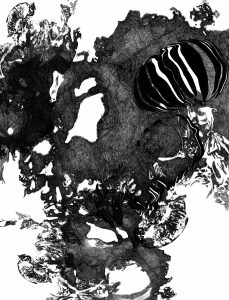The Best Digital Art of 2023
Outland’s guest editors share their favorite projects of the last year.

When I became Outland’s chief artistic director I was often asked what our NFTs will look like. I would always respond by saying I did not know, and I hope that answer remains the same for as long as Outland is commissioning art. I don’t have any preconceived notions for what a NFT should or shouldn’t be. They are created and used in a variety of ways: NFTs point to still images and looping videos that reside on distributed file systems, they are generated on-chain with potentially endless permutations, they serve as avatars and community identifiers, they encourage collective action by fractionalizing ownership, and so much more. Like any creative enterprise we must follow the visions of artists, for their innovative, iconoclastic views will point the way forward, not just by demonstrating what the technology and medium can do, but more importantly, by asking questions about what they ought to do, what concerns they should address, what responsibilities we each bear in our respective roles as artists, creative workers, and collectors.
In her iconic 1976 essay “Video: The Aesthetics of Narcissism,” art historian Rosalind Krauss ingeniously interprets video work made in the preceding years, much of which manipulates artists’ own self-images and self-reflections. She proposes that this burgeoning medium consists not of the camera, video monitor, and related equipment but rather narcissism, a psychological state as medium. For her, analog video constituted a certain mindset and attitude toward art; human psychology was the actual medium. And yet at this early stage of video art, Krauss could not anticipate how artists in the decades to come would use it to critique institutions and society, appropriate pop culture, re-examine history, evoke the speed of information, create immersive environments, and so much more—an explosion of the medium that blows Narcissus’s reflection out of the water.

I believe we are in a similar point with NFTs. Advocates and critics alike have a gut conception of what an NFT is and are quick to render judgment one way or another. After all, so much has happened in a relatively short amount of time, fostering an ever-growing community of creators and supporters. In this time of rapid innovation, I imagine any attempt to describe what an NFT is will only be made obsolete in short order. But like video did in the early ’70s, NFTs present a new orientation toward art, one in which information is much more transparent and the circulation of an artwork directly benefits its maker. As artists continue to explore and critique the ramifications of this new orientation, it will only expand what art can do, not just NFTs or digital art, but affecting creative practices of all kinds.
With the launch of our Marketplace, Outland is attuned to this shifting ground and to the myriad ways of making art on the blockchain. Through our curated program of drops, we seek to work with some of the most exciting artists who approach NFTs with deep experimentation, challenging what we know from a technological, social, and aesthetic perspective. Following this logic, each drop will take a sales format appropriate to the work itself, whether that may be a traditional or Dutch auctions, offering the work at an established buy-now price, or limiting the duration of sale. Works may be unique, editioned, iterations within a series, or some hybrid of these possibilities. By building in flexibility to accommodate the innovative unknowns of each artist’s work, I hope that our Marketplace becomes a place of generative confusion: upending expectations, asking fundamental questions about what’s what.
